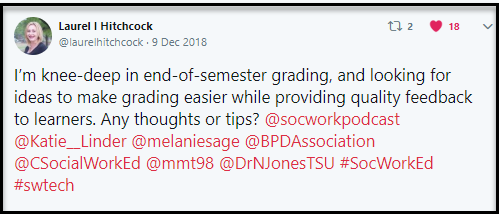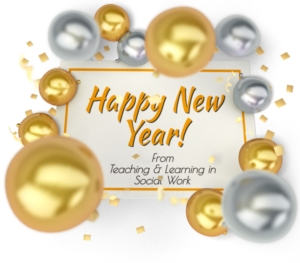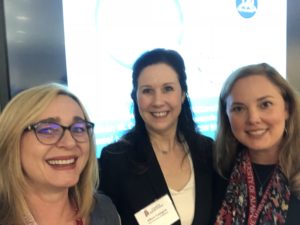Changing my grading practices in 2019: Tips for #SocWorkEd
At the end of last semester, I was grouchy about grading. If I am going to be truthful, I am always grouchy about grading. Don’t get me wrong; I love reviewing student work and offering feedback about their growth as a social work professional. What makes me grouchy about grading is that I don’t have a solid process for providing quality feedback in an efficient way. Every semester I find myself spending a lot of time typing comments and not really sure students are looking at anything but the grade. I keep up with grading comments in a word document and I use rubrics, and grading still feels overwhelming. So I decided to reach out to my professional network on Twitter for their suggestions and ideas.
I sent this tweet on December 9th:
And my colleagues did not disappoint; sharing some great ideas from using autotext software to employing self-care strategies. I captured their responses in a Twitter Moment and selected a few to try this semester. I am going to outline their ideas in this blog post, and try them out this semester, reporting back at the end of the semester about what worked and didn’t work for me.
Review of Teaching & Learning in Social Work for 2018
One of the reasons I like a good “end-of-the-year list” is the opportunity to reflect on what I did and did not miss out on over the past year. I’m always thrilled to discover I read one or maybe even two of the most notable books on the New York Times yearly list. Then, I start planning my reading wish list for the coming year, which usually involves magical thinking about reading every winner of the Nobel Prize for Literature or the all the Pulitzer Prize winners for Non-Fiction from the last ten years. Even if I don’t actually read all of these books, I believe in having some goals for my reading and other activities. For the Teaching and Learning in Social Work Blog, I had three goals for 2018:
1 .Write or publish 30 blog posts
2. Increase the number of blog subscribers from 100 to 200
3. Publish 10 guest educator blog posts
Here is how those goals worked out:
1. Wrote only 13 blog posts during the year, but published a total of 21 posts (70% completed)
2. Only added 40 more subscribers to the blog (40% completed)
3. Published 8 guest educators posts (80% completed)
While not all my goals were achieved, I was still able to collaborate with others to accomplish some solid writing for the blog including information about projects that I have been working on, and all my conference presentations for the year. Below is a list of this year’s posts, grouped around the topics of projects, guest educator posts, and conference presentations.
Projects: These posts describe new projects that I started or worked on during 2018:
#APM18 Teaching with Technology using the SAMR Model
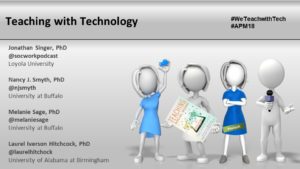 On Thursday, November 8, 2018, I will be presenting with Jonathan Singer, Melanie Sage & Nancy J. Smyth the Teaching Institute for Early Career Faculty at the Council on Social Work Education’s 2018 Annual Program Meeting. In this session, we are focusing on how faculty can incorporate technology into a social work course. All educators, especially those early in their careers, find themselves teaching from syllabi they had no role in developing. Although there are many benefits to the “hand-me-down” syllabus, one of the limitations is that assignments are rarely updated to reflect the realities of the 21st century workplace, which now includes the use of technology to achieve practice outcomes for clients and organizations. The purpose of this workshop is to learn about how to incorporate the use technology into a social work assignment on your syllabus, using Puentedura’s SAMR Module for Technology Integration. We will provide a brief overview of teaching with technology before focusing on how to infuse technology into an assignment from your syllabus, including learning objectives and associated assessment techniques in your syllabus. Participants will learn to identify ways to substitute, augment, modify or redefine existing learning strategies and assignments with technology-mediated learning strategies and assignments. By the end of the session, the participant will have an assignment that uses technology to meet the learning needs identified in the syllabus.
On Thursday, November 8, 2018, I will be presenting with Jonathan Singer, Melanie Sage & Nancy J. Smyth the Teaching Institute for Early Career Faculty at the Council on Social Work Education’s 2018 Annual Program Meeting. In this session, we are focusing on how faculty can incorporate technology into a social work course. All educators, especially those early in their careers, find themselves teaching from syllabi they had no role in developing. Although there are many benefits to the “hand-me-down” syllabus, one of the limitations is that assignments are rarely updated to reflect the realities of the 21st century workplace, which now includes the use of technology to achieve practice outcomes for clients and organizations. The purpose of this workshop is to learn about how to incorporate the use technology into a social work assignment on your syllabus, using Puentedura’s SAMR Module for Technology Integration. We will provide a brief overview of teaching with technology before focusing on how to infuse technology into an assignment from your syllabus, including learning objectives and associated assessment techniques in your syllabus. Participants will learn to identify ways to substitute, augment, modify or redefine existing learning strategies and assignments with technology-mediated learning strategies and assignments. By the end of the session, the participant will have an assignment that uses technology to meet the learning needs identified in the syllabus.
#APM18 Helping Social Work Students develop a Professional Online Presence for Interprofessional Communication
On Thursday, November 8, 2018, I will be presenting with Allison Curington and Mary Jacque Carroll, both field directors extraordinaire, at the Field Education Institute at the Council on Social Work Education’s 2018 Annual Program Meeting. As part of the institute, we are facilitating a one hour on how field educators can help social work students develop a professional online presence for interprofessional communication. We will be sharing information and tools that field directors can use to guide curricular development of learning approaches and assessment strategies to achieve practice outcomes around interprofessional communication with digital and social technologies. One of the tools we will be sharing is the second edition of Social Media Toolkit for Social Work Field Educators, which has been revised with content based on the 2018 NASW Code of Ethics.
You can access your free copy of the toolkit here: https://laureliversonhitchcock.org/2018/11/05/revised-social-media-toolkit/
Second Edition of the Social Media Toolkit for Social Work Field Educators
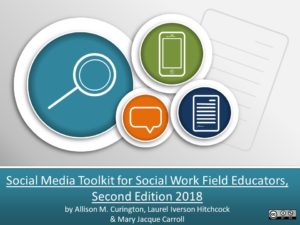 We are pleased to announce the availability of the second edition of Social Media Toolkit for Social Work Field Educators (2018), which has been updated to address the recent changes to the Code of Ethics from the National Association of Social Workers.
We are pleased to announce the availability of the second edition of Social Media Toolkit for Social Work Field Educators (2018), which has been updated to address the recent changes to the Code of Ethics from the National Association of Social Workers.
This toolkit provides social work field educators with tools and resources to help social work students and field instructors assess, develop, and maintain an online identity for professional purposes. There are two parts to the toolkit – an Educator’s Guide and a PowerPoint Slide Deck. The Educator’s Guide provides directions, descriptions, and handouts related to the content of the toolkit while the Slide Deck includes pre-formatted slides with selected content for presenting in the classroom or a workshop. The content of this toolkit is divided into six different topics centered on how to use social media professionally as a social worker:
1. Ethical Considerations for Social Media Use in Social Work Practice
2. Reflecting on Social Media Use in Social Work Practice
3. Engaging and Self-Assessment with Social Media
4. Professional Practice with Social Media
5. Case Studies for Students & Field Educators
6. Social Media Learning Activities for Field Education
Specific content for these topic areas include learning activities about why, when, and how to use social media as a practicing social work professional; skills for managing an online identity; guidelines for developing one’s own professional social media policy; and case studies to help develop professional and ethical competency.

